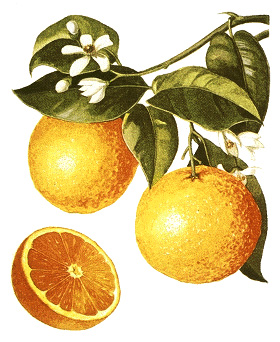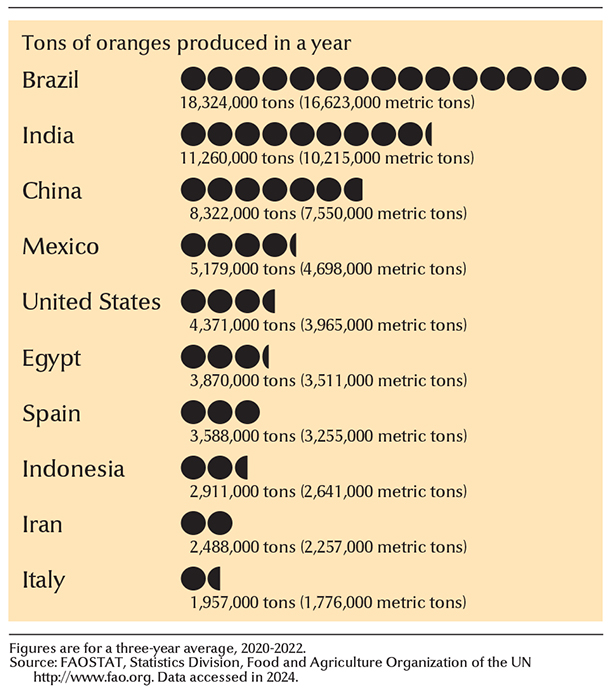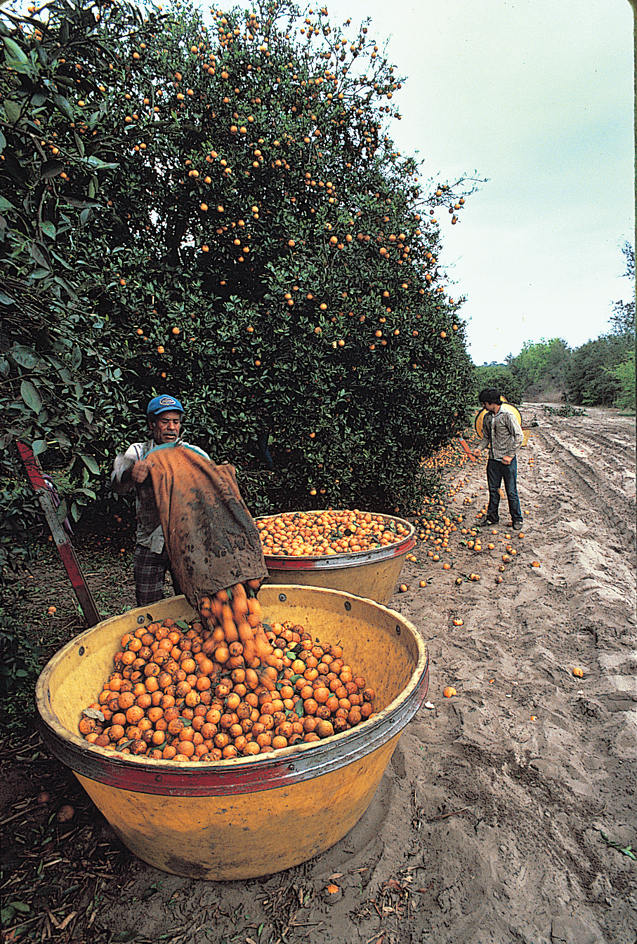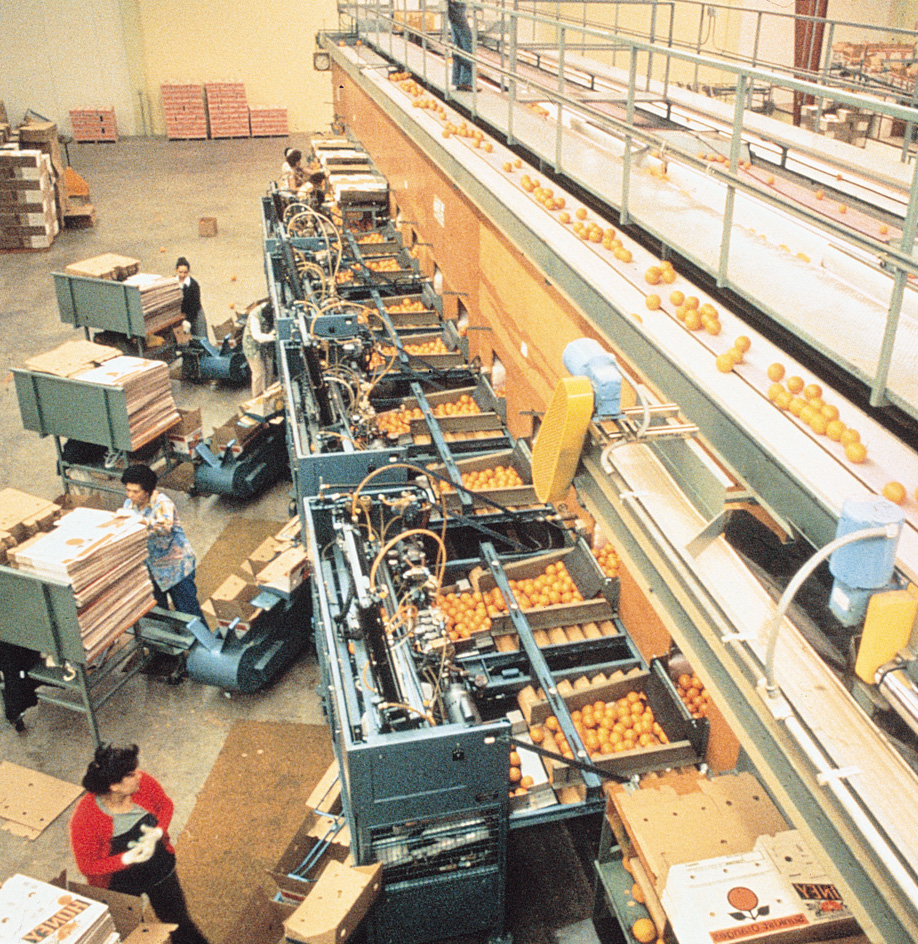Orange is a citrus fruit enjoyed throughout the world. Oranges are valued for their delicious juice and high vitamin C content. They are an excellent source of potassium. They also contain thiamine and folic acid.


About 84 million tons (76 million metric tons) of oranges are harvested throughout the world each year. Brazil is the leading orange-producing nation in the world.
In the United States, about 4.4 million tons (4.0 million metric tons) of oranges are harvested yearly. More oranges are harvested than any other fruit. California and Florida are the nation’s leading orange producers. Arizona and Texas also produce oranges.
Most of the oranges grown in the United States are processed into juice. Small amounts of oranges are used for making baked goods, candy, marmalade, soft drinks, and other food products. Most of the remaining orange crop is sold as fresh fruit. The orange peel, pulp, and rag (core and membranes) are used primarily as cattle feed supplements.
There are several types of oranges. The most popular is the sweet orange. Oranges vary in shape from round to oval. When ripe, the peel ranges from pink to orange to dark red in color. Oranges grow best in regions with warm summers and cool winters. The temperatures should not usually go below freezing. Freezing temperatures can damage the tree and the fruit.
The fruit and the tree
The orange is a type of berry called a hesperidium. The peel consists of two layers. There is a colored outer layer called the flavedo. Under the outer layer is a white, spongy inner layer known as the albedo. The flavedo contains tiny glands that contain a mixture of aromatic oils. The edible interior of the orange consists of 10 to 15 segments. The segments surround a spongy core. The segments contain many juice sacs. The sacs hold the juice and make up the pulp of the orange. The segments of some varieties of oranges also contain seeds. Other varieties of oranges are seedless. 
The orange tree has dark green leaves. In the spring, it has beautiful, white, fragrant flowers. Orange flowers do not require pollination by bees or other animals to produce fruit. The fruits are the ovaries of the flowers. Some varieties of oranges may be harvested within 7 months after the flowers bloom. Others may remain on the tree up to 16 months. Growers plant different varieties of oranges in the same area so that mature fruit is available during most or all of the year.
Orange trees develop new branches during periods of rapid growth called growth flushes. During these growth flushes, new stems, leaves, and often blossoms appear on the trees. Some of the flowers develop into fruit. The number and timing of growth flushes that occur each year vary according to the climate. There usually are two to five growth flushes per year. In climates like those of Florida and California, growth flushes do not occur during the winter. Instead, a period of vigorous growth takes place in the spring. During the spring growth flush, many flowers appear on the trees and a large number of fruits develop.
Varieties
The word orange commonly refers to three types of citrus fruit, sweet oranges, sour or bitter oranges, and mandarins.
Sweet oranges.
Growers around the world raise more sweet oranges than any other type of citrus fruit. These oranges have a sweet flavor. They are round to oval in shape. There are four groups of sweet oranges. These are (1) common or round oranges, (2) navel oranges, (3) blood oranges, and (4) acidless oranges.
Common oranges
are the most important type of sweet orange. Most oranges sold as fresh fruit are common oranges. In addition, almost all orange juice is made from common oranges. Juice from the Valencia orange, a type of common orange, makes the highest quality juice products. The Valencia is the most popular variety of orange in the world.
Navel oranges
have a small secondary fruit growing within the bottom end of the main fruit. They are seedless and have a pleasant flavor. But they produce less juice than do common oranges. They are best eaten as fresh fruit. California produces most of the U.S. navel-orange crop.
Blood oranges
have an unusual color. In other ways, they resemble common oranges. The flesh and peel of blood oranges range in color from light red to dark red. The oranges only become dark red in climates with cool night temperatures. Blood oranges are grown mostly in Mediterranean countries.
Acidless oranges
have a low level of acid in their juice. Consequently, they have a bland flavor. Acidless oranges have little commercial value except in Egypt and Brazil.
Sour or bitter oranges
generally are not eaten fresh because the flesh has a bitter taste. Sour oranges are widely used in making marmalade. Oils from the peel of some sour oranges and ingredients from the leaves and flowers are used in manufacturing perfume. This variety is often used as an ornamental plant.
Mandarins
are a group of fruits that includes true mandarins, tangerines, and various hybrids. Examples of hybrids are tangelos and tangors. Mandarins are not really oranges. But people often refer to them as oranges because of their orange color. Mandarins taste sweet and are generally eaten fresh. Their peel separates easily from their edible interior. See Mandarin; Tangelo; Tangerine; Tangor.
Raising oranges
Planting and caring for orange trees.
Most orange trees are grown from buds in special nurseries. A small piece of stem containing a bud is cut from a tree that produces the variety of orange desired. The stem is then grafted to a seedling orange tree called a rootstock (see Grafting (Other kinds of grafting)). Rootstock varieties are selected for their ability to produce high-yielding trees. They must also adapt to the local soil and climate, and resist pests and disease. Because oranges are grown from the buds of other orange trees, each new tree is a clone (genetic copy). Orange trees are transplanted in groves 6 to 12 months after grafting. They start to bear fruit 2 to 4 years later. A tree may produce oranges for 50 years.
Pests and diseases.
Orange trees are attacked by many pests and diseases. Scale insects suck the sap from the fruit, leaves, and twigs. Certain wasps kill these insects. To control scale insects, growers foster the growth of these wasps in orange groves. Two other sucking pests, rust mites and aphids, also damage the leaves. These pests are killed by spraying the trees with pesticides. Nematodes and weevils may attack orange roots. Some insects, such as aphids, may carry serious citrus diseases.
Diseases caused by bacteria weaken or kill orange trees. The bacterial diseases huanglongbing (citrus greening) and citrus canker are especially deadly. Diseases caused by viruses, such as tristeza, also are deadly. Such fungal diseases as greasy spot, melanose, and sweet orange scab also cause damage. Growers control diseases by using sprays, by planting trees that are resistant, by removing diseased trees, and by other methods. 

Harvesting and processing.
As oranges mature, the amount of sugar and juice they contain increases. At the same time, their acid content decreases. Oranges and other citrus fruit do not mature further after they have been harvested. They differ from most other fruit in this way. For this reason, growers pick the oranges only when the fruit contains the desired levels of juice, sugar, and acid.
If oranges are pulled from the trees roughly, they may be bruised or damaged. These damaged fruit may be easily attacked by fungal diseases that cause decay. For this reason, oranges to be sold as fresh fruit are carefully harvested from the trees by hand. They are then transported to packing houses in large bins that hold as much as 900 pounds (400 kilograms) of oranges. The oranges are then washed, dried, and graded on their appearance. Next, they are waxed with an edible coating that prevents dehydration and improves their appearance. The oranges are then sized, packed into boxes, and shipped to markets. Some mature oranges have a partly green peel. They may be treated with ethylene gas to reduce the green color of the peel.
Oranges that are to be sold for processing can be harvested by hand or shaken off the tree using a machine. They are then transported in bulk by truck. If they are processed within a few days, few losses are suffered from bruising or decay. The juice is extracted from the fruit by machine. The juice is then heat-treated to kill microbes and to inactivate enzymes.
History
Oranges are among the oldest cultivated fruits. People have grown oranges for more than 4,000 years. Oranges probably originated in the part of Asia that now includes India, Myanmar, and southwestern China. By the A.D. 800’s, Arab traders had introduced oranges into eastern Africa and the Middle East. In the 1400’s, Portuguese explorers carried oranges from India to Europe. The Italian explorer Christopher Columbus brought orange seeds to America in 1493. During the 1500’s, European settlers planted orange trees in Florida and Brazil. The first orange groves in California were established by Spanish missionaries in the late 1700’s. The major varieties of oranges grown today were selected during the 1800’s and early 1900’s.
The orange industry has grown rapidly since the early 1900’s. At that time, oranges were rare and expensive. Many people ate them only as a treat on holidays. Today, because of improved growing methods and other factors, most people can afford oranges and orange juice throughout the year.
